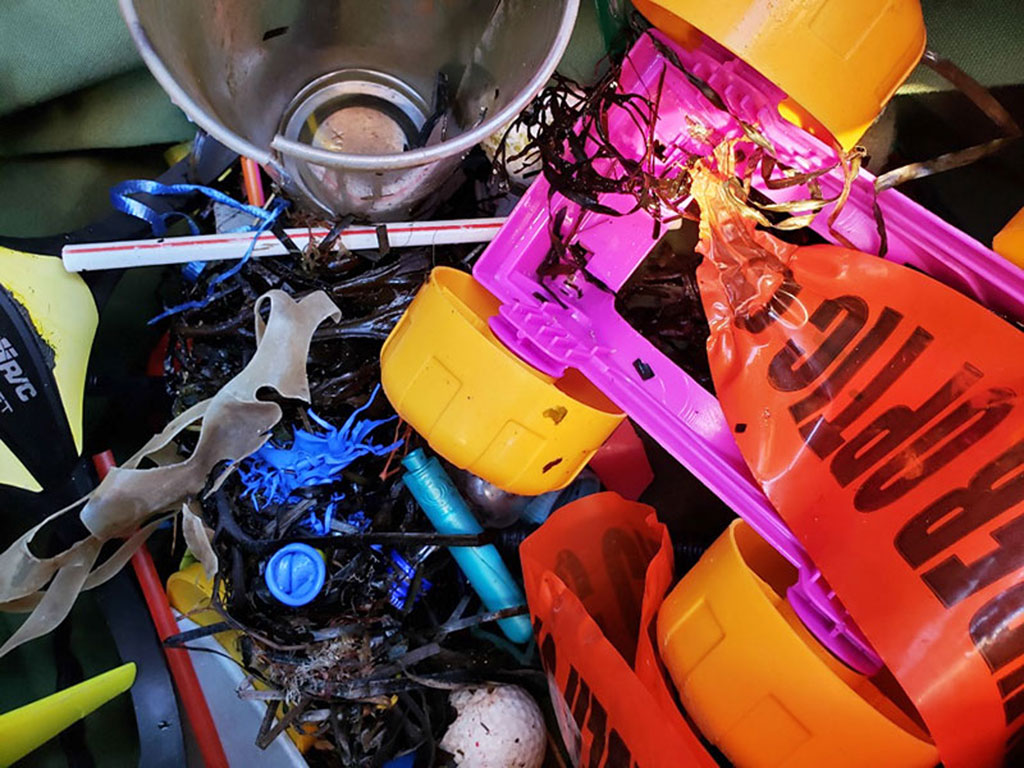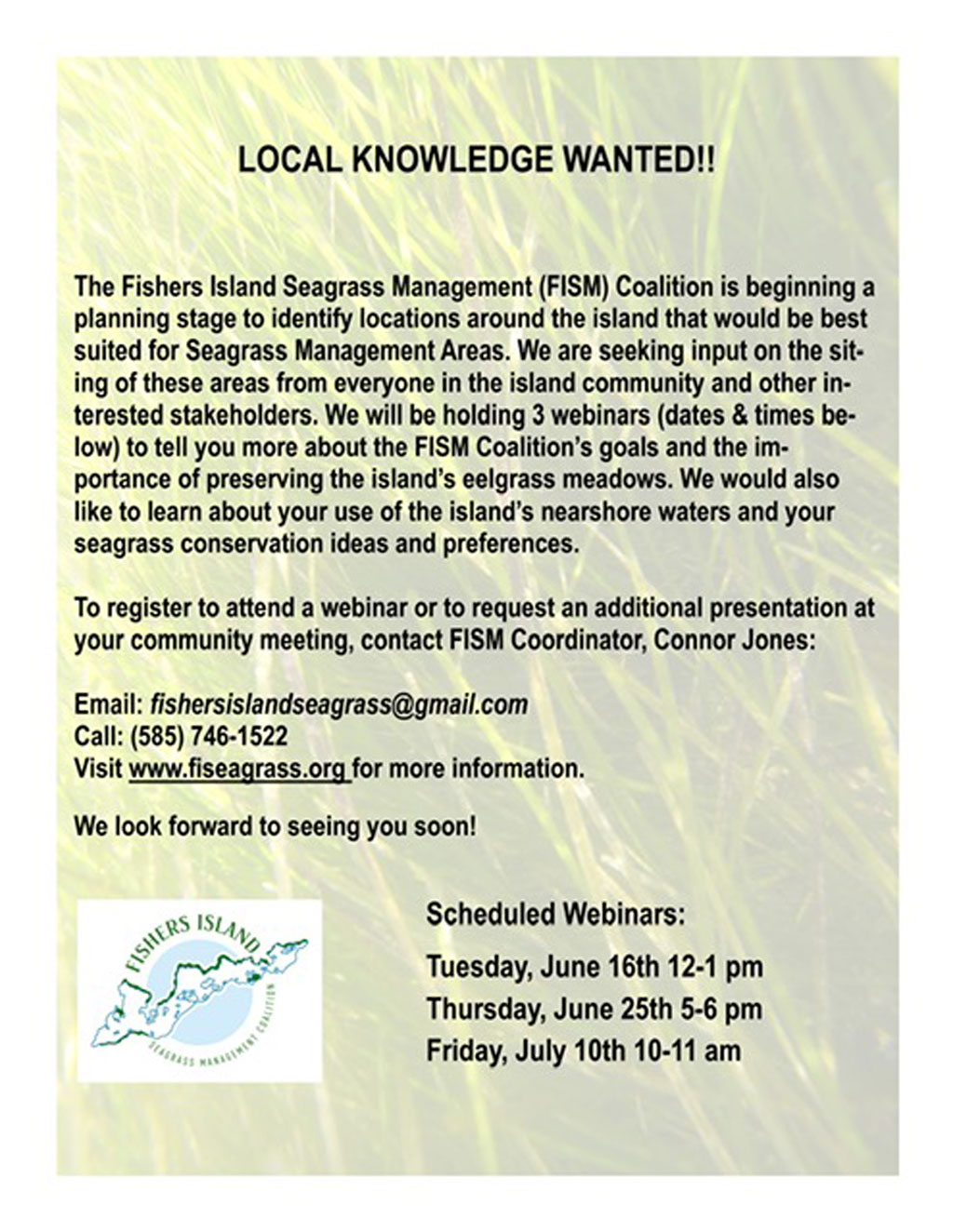
Tons of marine debris on Fishers Island beaches and shoreline provide a never-ending clean-up challenge for FIConservancy employee Michele Klimczak. Michele Klimczak Photo
Memorial Day brings the official start to our Fishers Island summer. Help us maintain a clean and healthy environment on Fishers Island: Please grab a bag and pick up debris that you see on or near our beaches and coastline.
In 2019, Island resident Michele Klimczak collected an astounding 8,441 pounds of marine debris from the shores of Fishers Island.
FIConservancy employs Michele to patrol multiple Island locations (listed below) and clear away marine debris. For example, in just one day (Feb. 20, 2019), Michele collected 49 lbs. of debris at the Hay Harbor Club Beach:
Approximately 35 plastic bags sticking out of low tide sand, plastic cups, silverware, containers, bottles, pens, straws, drink stirrers, frisbee, flip flop, mylar and rubber balloons, balloon ribbon, fishing line, string, rope pieces, broken toys, bottle caps, cans, netting, pail. Two large plastic pieces, hose/tubing, wire, broken styrofoam and cups, food containers, food/snack/candy wrappers, full bag of green beans, cigar tips, tampon applicators, drink cup lids, plastic gallon jugs.
Thank you for joining in our mission to help preserve and enhance Fishers Island’s natural resources and surrounding waters. Together, we can help protect the future of our beautiful island!
Locations of FIConservancy Marine Debris Collection:
Latimer Light beach, Clay Point Road beaches, Dock Beach, South Beach, Sanctuary of Sands near South Beach, Race Point beaches, Elizabeth Airport beaches, Silver Eel Cove, Little Stony beach, beaches behind Money Pond, Chocomount Beach, Chocomount Cove, South Dumpling beaches, Isabella Beach, beaches before Big Club, Grey Gulls, Holiday House beaches, Houghton beach, beach at bottom of Four Corners road, beach at stables, beaches to left of Castle Road, Hay Harbor Club beach. (Sent as blast May 26, 2020.)
Fishers Island Seagrass Management Coalition Seeking Input from Fishers Island Community
NewsThe Fishers Island Seagrass Management Coalition (FISM) has scheduled three Webinars as they begin to identify the best locations for future seagrass management areas around Fishers Island. FISM is seeking input from the entire Fishers Island Community as to preferred use of inland waters and seagrass conservation ideas.
During the Webinars, FISM Coordinator Connor Jones will talk about FISM’s goals and the importance of preserving the Island’s eelgrass meadows. Fishers Island has 94 percent of the remaining eelgrass in Long Island Sound’s New York waters and 25 percent of all eelgrass in the Sound.
Spring 2020 Migratory Bird Count
NewsEight birdwatchers observed 45 species in the Spring 2020 Migratory Bird Count May 2 under cloudy skies with cool temperatures in the low 50s F. The group donned masks and practiced social distancing as they proceeded through Audubon’s required 15 five-minute stops across the Island.
“We saw a sedge wren in a pond before the Big Club,” said Tom Sargent, group leader and president of FIConservancy. “Those birds like cattails, which have been obliterated by phragmites, so we did not expect to see this bird.
“But just at the end of the area, we found a few cattails left, and that’s where we saw the wren. Phragmites are so thick that birds cannot nest and therefore cannot breed there. This shows the importance of habitat.”
Migration may have been slow due to a chilly April, because the count was down from the past two years. There were 56 species counted in spring 2019, 55 species in spring 2018 and 45 species in spring 2017.
Stayed tuned for the 2020 Fall Migratory Bird Count in September. There were 45 species noted for the Fall 2019 count.
Kristen Peterson Photos
An osprey soars above Fishers Island’s birdwatchers.
Two Tons of Marine Debris Littered FI Coastline in 2019
NewsTons of marine debris on Fishers Island beaches and shoreline provide a never-ending clean-up challenge for FIConservancy employee Michele Klimczak. Michele Klimczak Photo
Memorial Day brings the official start to our Fishers Island summer. Help us maintain a clean and healthy environment on Fishers Island: Please grab a bag and pick up debris that you see on or near our beaches and coastline.
In 2019, Island resident Michele Klimczak collected an astounding 8,441 pounds of marine debris from the shores of Fishers Island.
FIConservancy employs Michele to patrol multiple Island locations (listed below) and clear away marine debris. For example, in just one day (Feb. 20, 2019), Michele collected 49 lbs. of debris at the Hay Harbor Club Beach:
Approximately 35 plastic bags sticking out of low tide sand, plastic cups, silverware, containers, bottles, pens, straws, drink stirrers, frisbee, flip flop, mylar and rubber balloons, balloon ribbon, fishing line, string, rope pieces, broken toys, bottle caps, cans, netting, pail. Two large plastic pieces, hose/tubing, wire, broken styrofoam and cups, food containers, food/snack/candy wrappers, full bag of green beans, cigar tips, tampon applicators, drink cup lids, plastic gallon jugs.
Thank you for joining in our mission to help preserve and enhance Fishers Island’s natural resources and surrounding waters. Together, we can help protect the future of our beautiful island!
Locations of FIConservancy Marine Debris Collection:
Latimer Light beach, Clay Point Road beaches, Dock Beach, South Beach, Sanctuary of Sands near South Beach, Race Point beaches, Elizabeth Airport beaches, Silver Eel Cove, Little Stony beach, beaches behind Money Pond, Chocomount Beach, Chocomount Cove, South Dumpling beaches, Isabella Beach, beaches before Big Club, Grey Gulls, Holiday House beaches, Houghton beach, beach at bottom of Four Corners road, beach at stables, beaches to left of Castle Road, Hay Harbor Club beach. (Sent as blast May 26, 2020.)
Native or Non-Native Praying Mantis? All Three Species Live on Fishers Island
NewsFishers Island has both native and non-native praying mantises. It is important to know the difference. The above Carolina praying mantis is native.
A Tale of Two Nests
NewsBrown-headed cowbirds lay their speckled eggs in the nests of other birds, who raise those hatchlings at the expense of their own young.
Parade Grounds Paths Widened to Six Feet
NewsExciting News: Breeding American Woodcocks on FI
NewsFirst sighting of breeding American woodcock on Fishers Island in many years. Kyle Kibbe Photo
The American woodcock is neither endangered nor globally threatened. Island residents have reported seeing woodcocks in the Parade Grounds, and its song was documented in the Parade Grounds during the 2018 spring migration.
The exciting news, however, is that this is the first example of a breeding pair on Fishers Island for some time. These birds were spotted April 11 near South Beach. They have clearly benefited from ongoing grassland restoration in the Parade Grounds, Elizabeth Airport, Race Point and South Beach.
Although classified with sandpipers as shorebirds, American woodcock spend most of their time hidden in fields and on the forest floor probing for earthworms where the soil is moist.
The population of the American woodcock has fallen by an average of slightly more than 1% annually since the 1960s. Most authorities attribute this decline to a loss of habitat caused by forest maturation and urban development.
There are many colorful folk names for the American woodcock. These include timberdoodle, bogsucker, night partridge, brush snipe, hokumpoke, twitterpate, little gomer, fiddle squeak, worm sabre, wafflebird, bumblebee chicken, mud needle, prairie turtle, and crazy straw.
Time is Right to Attack Aggressively Invasive Mustard Garlic
NewsFishers Island is awash in mustard garlic. This plant is a tenacious invasive weed that exudes a chemical through its roots that inhibits native plants from growing. The flowers are self-fertile and rarely wilt without producing a hoard of seeds.
“This stuff IS ALL OVER the Island. It is really easy to pull up and bag. It’s up to individual property owners to do their best to pull this weed before seed pods develop. Each plant produces 600 seeds that remain viable in the soil for five years or more,” said FIConservancy President Tom Sargent.
“Folks can even weed while taking a walk, although it’s hard for me to take a walk, because I am always stopping, pulling and bagging!”
Mustard garlic was brought to North America by early European settlers to use as medicine and food.
The Truth About Swans
NewsNesting mute swans in late April near 4th hole at the Fishers Island Club golf course. Meredith Doyen Photo
It’s hard to resist the Hans Christian Andersen fairy tale, when an ugly duckling grows into the most beautiful swan in the pond.
Unfortunately, New York State’s largest bird can be aggressive to humans, and their voracious appetites often disturb local ecosystems, displacing native species.
Mute swans eat up to eight pounds of submerged aquatic vegetation, including eelgrass, daily. They sometimes completely uproot plants, and often, adult swans will uproot more plants than they actually consume.
Mute swans are not native to North America. They are descendants of swans brought to this country in the late 1800s through early 1900s to adorn large estates, city parks and zoos. They are now a “prohibited” invasive species, which prohibits the sale, importation, transport or introduction of this species in New York State.